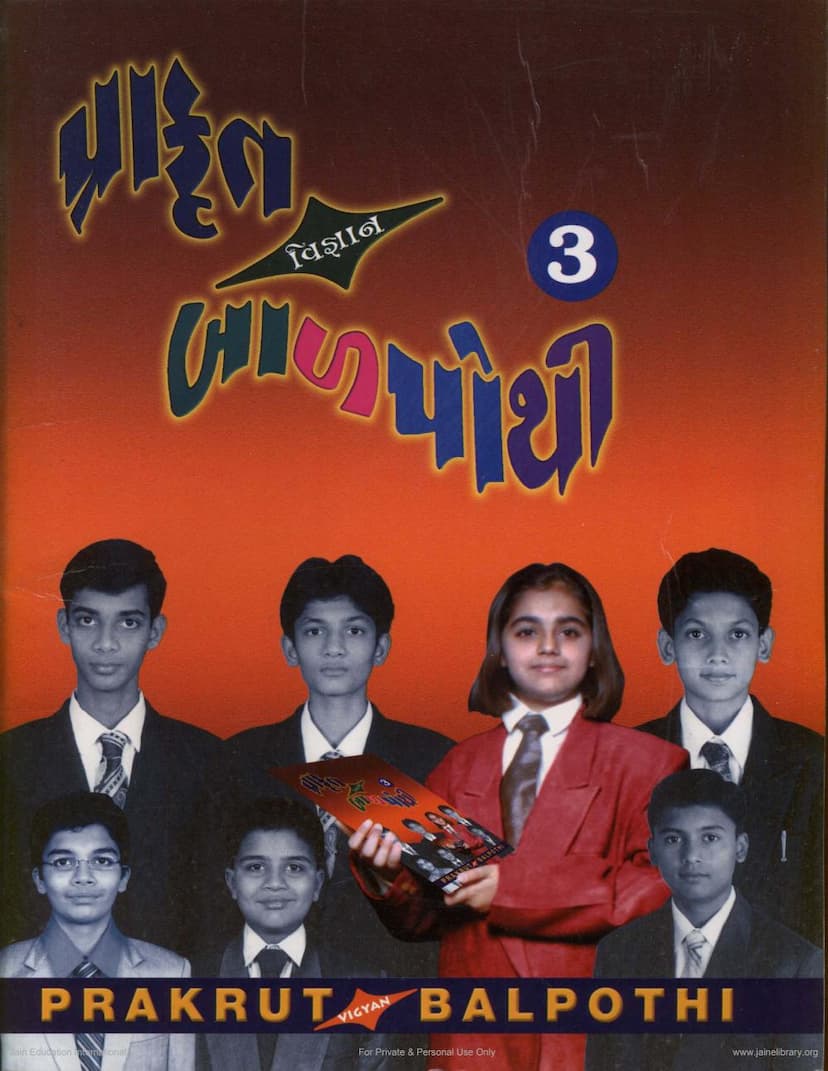Prakrit Vigyana Balpothi Part 3
Added to library: September 2, 2025

Summary
The provided document is "Prakrit Vigyan Balpothi Part 3," authored by Somchandravijay and published by Rander Road Jain Sangh. This book is part of a series dedicated to the study of the Prakrit language, a significant language in Jain literature.
Here's a comprehensive summary based on the provided pages:
Overall Purpose:
The book is a comprehensive educational resource designed to teach the Prakrit language to children and students. It aims to revive interest in Prakrit, which is considered the mother tongue of the Jain tradition, and make its study accessible and engaging. It is presented as a tribute to Acharya Shree Vijay Kastursuri M.S., a renowned scholar of Prakrit.
Key Content and Structure:
The "Prakrit Vigyan Balpothi" is structured into multiple "steps" (pages are numbered as steps), systematically introducing the fundamentals of the Prakrit language.
- Introduction of Scripts (Page 2): The book begins by displaying various scripts, including Prakrit, Sanskrit, Gurumukhi, and English, establishing a multilingual context.
- Gurus and Dedication (Pages 3-10): Several pages are dedicated to honoring the lineage of esteemed Jain Acharyas who inspired and guided the creation of this book. Notably, it highlights the contributions of Acharya Shree Vijay Nemisuriswarji Maharaj, Acharya Shree Vijay Vigyansuriswarji Maharaj, and especially Acharya Shree Vijay Kastursurishwarji M.S., to whom the book is a tribute for his work in Prakrit preservation and propagation.
- Linguistic Foundations (Steps 1 onwards):
- Vowels and Consonants (Steps 1, 2, 13): The book meticulously details the Prakrit vowels (swars) and consonants (vyanjan), explaining their classification, pronunciation, and how they differ from Sanskrit. It clarifies which letters are used and which are not or have changed forms in Prakrit.
- Tenses (Step 2, 13): It explains the five tenses used in Prakrit: present, past, imperative/optative, future, and a specific tense for the completion of an action.
- Number and Gender (Steps 7-11, 15-18): The book systematically covers the concept of dual and plural numbers and the different genders (masculine, feminine, neuter) in Prakrit grammar. It provides declensions for various noun types ending in 'a', 'i', 'u', 'ī', 'ū', 'ṛ', and 'i'.
- Cases (Step 7, 15): It outlines the seven cases (prathama, dwitiya, tritiya, chaturthi, panchami, shashti, saptami) used in Prakrit grammar, illustrating their usage with examples.
- Verb Roots and Forms (Steps 2, 4, 6, 15, 16, 17, 18): A significant portion of the book is dedicated to teaching Prakrit verbs. It introduces common verb roots (dhatus) and demonstrates how they conjugate in different tenses, persons, and numbers.
- Vocabulary and Sentence Construction (Steps 3, 5, 8, 9, 10, 12, 19): The book includes lists of common Prakrit words, pronouns, adverbs, and adjectives. It then guides students in forming Prakrit sentences through translation exercises from Gujarati to Prakrit and vice-versa.
- Adjectives (Step 10): It explains the role of adjectives (visheshana) in describing nouns (visheshya) and how their forms change according to gender and number.
- Stories and Examples (Pages 61-66): The book features didactic stories ("Paathshaala," "Sanhai Kaj-sahiga," "Aariyo BaalgO") in Prakrit with Gujarati translations and moral lessons. These stories illustrate concepts of unity, kindness, and upholding good conduct, reinforcing the Jain ethical principles.
- Supplementary Section (Pages 44-56): This section acts as an answer key and reference, providing the correct forms of verbs, Prakrit sentences with Sanskrit/Gujarati translations, and vice versa. This allows students to self-assess their learning.
- Jain Cosmology and Concepts (Pages 57-61): The book also includes diagrams and lists related to Jain cosmology, such as the Fourteen Rajlok (realms of existence), different types of heavenly beings (Devas), and the structure of the universe according to Jain philosophy. This contextualizes the language learning within the broader Jain worldview.
Key Themes and Objectives:
- Revival of Prakrit: The primary goal is to promote and preserve the Prakrit language, a treasure trove of Jain literature.
- Holistic Jain Education: Beyond language, the book imparts Jain ethical values and philosophical concepts through stories and examples.
- Accessibility for Learners: The step-by-step approach, use of illustrations (implied by the mention of pictures in the introductory pages), and translation exercises make the language accessible to beginners.
- Dedication to Gurus: The profound respect and reverence for the Acharyas are evident throughout the book, emphasizing the importance of the guru-shishya tradition.
In essence, "Prakrit Vigyan Balpothi Part 3" is a meticulously crafted educational tool that aims to not only teach the Prakrit language but also to foster a deeper understanding and appreciation of Jainism among its young readers.